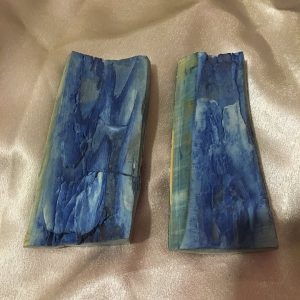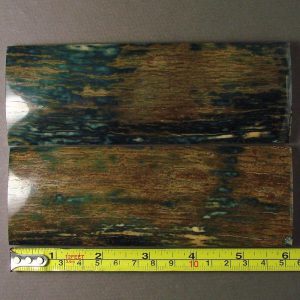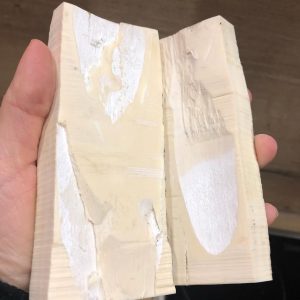Mammoth Bark Ivory
Mammoth Bark Ivory represents the stunning outer layer of prehistoric woolly mammoth tusks, preserved in Siberian permafrost for over 10,000 years. Unlike the uniform white inner core, bark ivory showcases extraordinary natural colorations—from rich earth tones to captivating mineral-stained patinas—making each piece utterly unique. Prized by master craftsmen and artisans worldwide, our premium bark selections deliver exceptional character for high-end knife handles, luxury pistol grips, bespoke jewelry, and fine woodworking inlays where visual drama meets ancient authenticity.
Showing all 9 results
Understanding the Unique Appeal of Mammoth Bark
The outer bark layer of ancient mammoth tusks tells a geological story spanning millennia. While conventional ivory offers classic elegance, bark presents something far more distinctive. Through thousands of years buried within frozen tundra, these outer layers absorbed minerals from surrounding soil, creating spectacular color variations impossible to replicate. Each specimen displays its own personality—some reveal warm amber and chocolate hues, others exhibit slate grays with turquoise undertones, and many showcase dramatic transitions between multiple shades. This natural artistry transforms functional materials into conversation pieces.
Professional artisans recognize bark’s superior aesthetic versatility. The textured surface and varied coloration provide visual interest that solid ivory simply cannot match. When paired with polished steel in custom knives or contrasted against precious metals in jewelry, bark ivory creates striking focal points. High-end gun makers specifically seek these pieces for pistol grips that demand attention, while furniture craftsmen incorporate bark into exclusive inlay work where distinction matters.
Sourcing and Quality Standards That Matter
Authentic mammoth bark ivory originates exclusively from legally recovered tusks found in Arctic regions, primarily Siberia, Alaska, and Northern Canada. Recovery teams work in challenging conditions during brief summer months when permafrost briefly thaws. Unlike protected elephant ivory, working with mammoth materials supports no illegal trade—these animals disappeared roughly 4,000 years ago, making every piece a guilt-free choice for environmentally conscious artisans.
Quality assessment requires expertise. Superior bark exhibits structural integrity without excessive cracking, maintains workability for detailed applications, and displays rich natural coloration throughout. Our selection undergoes rigorous evaluation—we reject compromised specimens and only stock materials that meet professional craftsman standards. Every piece receives controlled drying treatment lasting months or years, ensuring stability for precision work. This preparation prevents warping, splitting, or dimensional changes during your creative process.
Working with Bark: What Craftsmen Should Know
Mammoth bark ivory machines beautifully with standard woodworking and bone-working tools. The material responds well to sawing, drilling, filing, and sanding without requiring specialized equipment. Most artisans find bark slightly softer than inner core ivory, making it more forgiving for intricate carving or detailed inlay work. This workability, combined with natural color variation, explains why experienced knife makers often prefer bark for handle scales—it accepts fine finishing while displaying organic character.
Stabilization enhances performance for demanding applications. Professional stabilization saturates the material with hardening resins, increasing density and durability while preserving natural appearance. Stabilized bark handles humidity changes better, takes a higher polish, and resists impact damage—critical factors for working tools or frequently-handled pieces. Whether you need raw natural bark for carving projects or professionally stabilized material for functional knife scales, matching the right preparation to your intended use ensures optimal results.
Applications Beyond Traditional Crafts
Modern artisans continue discovering innovative uses for this prehistoric material. Jewelry designers create distinctive pendants, earrings, and statement rings that command premium prices. Musical instrument builders incorporate bark into guitar and mandolin inlays, adding historical gravitas to custom instruments. Pen turners produce luxury writing instruments with genuine conversation-starting appeal. Even contemporary artists use bark in mixed-media sculptures, combining ancient materials with modern concepts.
FAQs About Mammoth Bark Ivory
What makes bark ivory different from regular mammoth ivory? Bark forms the tusk’s protective outer layer and displays dramatic natural colorations from mineral absorption, while inner core ivory typically presents uniform cream or white tones with subtle grain patterns.
Is mammoth bark ivory legal to buy and work with? Absolutely. Mammoth ivory faces no legal restrictions since woolly mammoths became extinct thousands of years ago. Unlike endangered elephant ivory, mammoth materials remain completely legal worldwide for commercial and personal use.
How old is authentic mammoth bark ivory? Most available mammoth bark ranges from 10,000 to 40,000 years old, though some specimens discovered in deeper permafrost layers may exceed 100,000 years, dating to earlier mammoth species migrations.
Does bark ivory require special care or maintenance? Once properly dried and optionally stabilized, bark ivory remains remarkably stable. Avoid prolonged water exposure, extreme temperature swings, and direct harsh chemicals. Occasional application of natural oils maintains luster on finished pieces.
Can beginners work with mammoth bark ivory successfully? Yes. Bark ivory works similarly to dense hardwoods or bone, making it accessible for craftspeople comfortable with basic woodworking tools. Starting with smaller pieces allows skill development before investing in premium specimens.
What determines mammoth bark ivory pricing? Size, color intensity, pattern complexity, structural integrity, and overall aesthetic appeal all influence value. Rare colorations—deep blues, vibrant oranges, or striking multi-tone pieces—command premium prices among collectors and master craftsmen.














